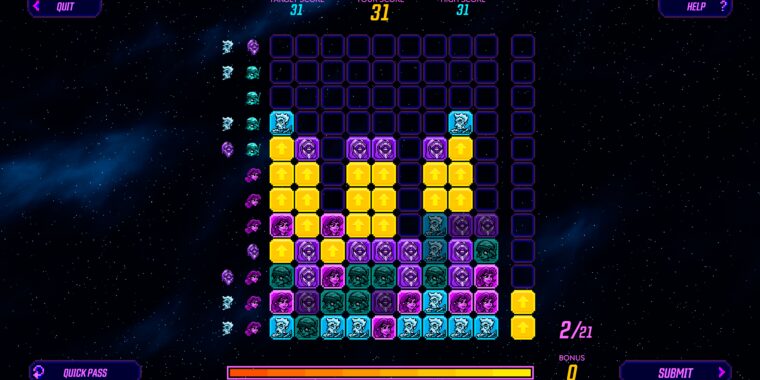In 2020, a new minigame appeared in the video game Borderlands 3, located in the resident scientist’s laboratory on the spaceship Sanctuary III. Although the arcade game may seem like just another way to pass in-game time, the tile-matching puzzle game—Borderlands Science—has allowed millions of players to help map the human gut microbiome.
Borderlands Science is one of the first examples of a citizen science game being embedded in a mainstream video game; it translates players’ tile matching into sequence alignment of microbial DNA strands that encode ribosomal RNA. Ultimately, this can help deduce the genetic relationships between different gut microbes—crucial information for demystifying the complex web of interactions among diet, disease, and microbiome.
Since launch, over 4 million gamers have played Borderlands Science, collectively solving over 100 million puzzles, making this one of the largest citizen science projects ever. Not only has the game generated huge player engagement, but the results have outperformed state-of-the-art computational methods, according to an analysis of the project published in Nature Biotechnology.
“We didn’t know whether the players of a popular game like Borderlands 3 would be interested or whether the results would be good enough to improve on what was already known about microbial evolution. But we’ve been amazed by the results,” said Jérôme Waldispühl, a professor at McGill University and senior author of the paper, in a statement.
Back to the drawing board
Often, citizen science games closely resemble the actual scientific task being carried out and involve finding solutions to complex problems, such as optimizing protein folding in Foldit. Although this has the potential of generating very useful results, the complexity can be off-putting and reduce player engagement and retention, restricting the audience to people with a prior interest in science.
Borderlands Science takes a new design approach to try to overcome these challenges, breaking the overall scientific problem into lots of bite-sized puzzles. This isn’t as straightforward as it sounds, as there is no “ground truth” with RNA sequence alignment, making it impossible to grade a puzzle solution as simply right or wrong. Instead, each puzzle makes a small contribution to optimizing an overall sequence solution.
This simplification, or gamification, means people are more likely to engage with the tasks, but even if a player completes only a few puzzles, it’s still useful. Compare this to Foldit, where if a player gives up after fiddling with the protein structure for 10 minutes, nothing is gained.
Successfully modularizing the problem is one of the key innovations of the work, Sebastian Deterding told Ars, a professor at Imperial College London whose work includes citizen science games. “As long as we get enough eyeballs at the beginning, even if we just keep people for two or three puzzles, that’s enough.”
Additionally, the developers have kept game design front and center, aiming to produce a game that, at its core, is simply fun to play. Gearbox Games, the developer of the bestselling Borderlands franchise, carefully designed the minigame to fit seamlessly into the series’ distinctive art and atmosphere, including dialogue with existing characters, so as not to break immersion.
A risk that paid off
Designing citizen science games is a balancing act between making tasks simple and fun enough to engage users but complex enough to generate meaningful results. The simpler the task, the more people you need to engage with it to produce data. For Borderlands Science, the hyper-gamification gamble worked. Although the task was more gamified than any citizen science game had come before, the huge player engagement it generated more than compensated for this simplification.
The game dramatically outperformed its predecessor, Phylo, which is a free-to-play standalone game made with a less gamified interface: “In half a day, the Borderlands Science players collected five times more data about microbial DNA sequences than our earlier game, Phylo, had collected over a 10-year period,” said Waldispühl in a statement.
Although Borderlands Science has generated some excellent data and has shown integrating science into mainstream games can work well, Deterding is skeptical about whether other teams will be able to adopt this approach.
“Data sharing with industry is super fraught, and is super dependent on just you happening to have a connection,” he told Ars. “It would be interesting if we could convince entertainment game companies that this would be a nice corporate social responsibility initiative that more of them could do and should do, and could do easily. But again, right now, I think it’s a very brittle and precarious pathway.”
Nature Biotechnology, 2024. DOI: 10.1038/s41587-024-02175-6
Ivan Paul is a freelance writer based in the UK. He recently finished his PhD in cancer research. He is on Twitter @ivan_paul_.


/cdn.vox-cdn.com/uploads/chorus_asset/file/25430225/247065_Vergecast_Gaming_Senses_Smell_SHaddad.png)



